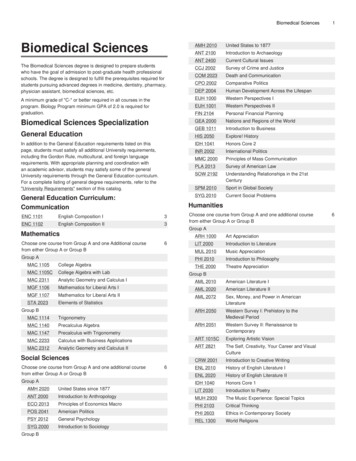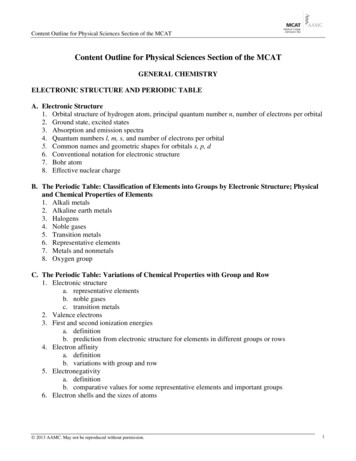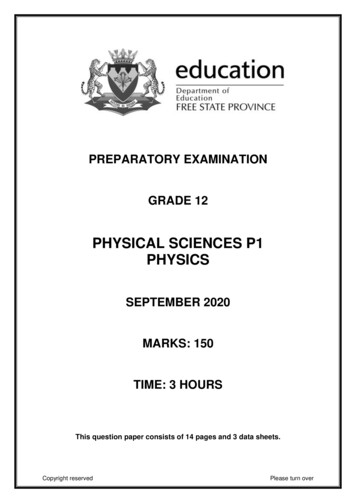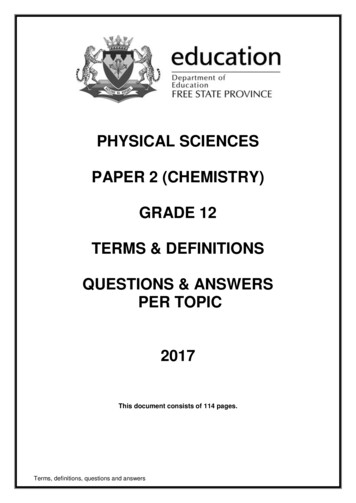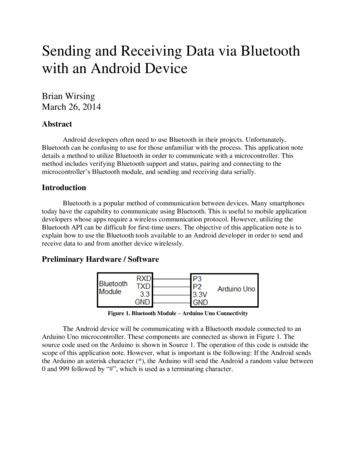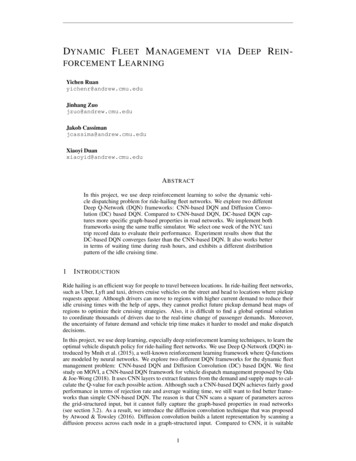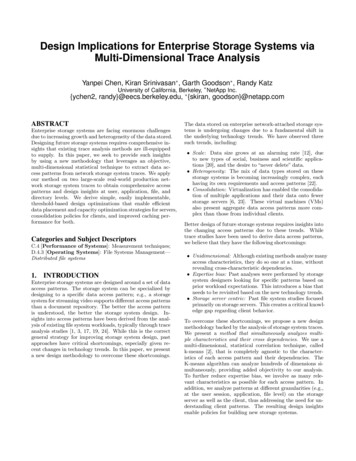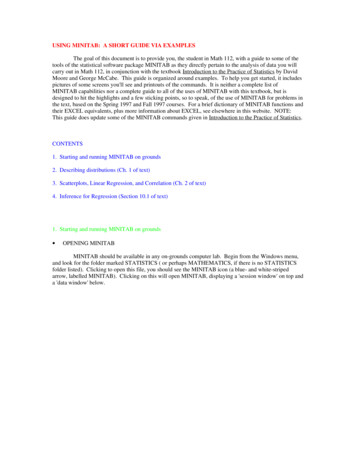
Transcription
performing well. It makes your heart feel so glad andgreat, and you really feel you’ve achieved somethingwhen you get your learners on the road to success.Grade 10 Teacher’s GuideWhat’s rewarding to me is to see my learnersThe accompanying Learner’s Book is written in accessible language and contains all the content your learners need to master.The exciting design and layout will keep their interest and make teaching a pleasure for you.We would love to hear your feedback. Why not tell us how it’s going by emailing us at physicalsciences@viaafrika.com?Alternatively, visit our teacher forum at www.viaafrika.com.Language: Englishwww.viaafrika.comVia Afrika Physical Sciences1. The series was written to be aligned with CAPS. See page 39 to see how CAPS requirements are met.2. A possible work schedule has been included. See page 7 8 to see how much time this could save you.3. Each topic starts with an overview of what is taught, and the resources you need. See page 23 to find out how this willhelp with your planning.4. There is advice on pace-setting to assist you in completing all the work for the year on time. Page 24 shows you how thisis done.5. Advice on how to introduce concepts and scaffold learning is given for every topic. See page 9 25 for an example.6. All the answers have been given to save you time doing the exercises yourself. See page 26 for an example.7. Also included are a full-colour poster and a CD filled with resources to assist you in your teaching and assessment. Seethe inside front cover.8. A question bank with tests you may photocopy will help you assess your learners effectively. See the Question Bank onpage XX.Grade 10 Study GuideD.B. Gibbon, R. Jones, J.E. Patrick, M. Patrick, S.T. Townsend,T. van Niekerk, T.E. Luvhimbi, N.P. Mlobeli— Adam Joseph, TeacherVia Afrika understands, values and supports your role as a teacher. You have the most important job in education, and werealise that your responsibilities involve far more than just teaching. We have done our utmost to save you time and makeyour life easier, and we are very proud to be able to help you teach this subject successfully. Here are just some of the thingswe have done to assist you in this brand-new course:Via AfrikaPhysical Sciences
D.B. Gibbon R. Jones J.E. Patrick M. Patrick S.T. Townsend T. van NiekerkStudy GuideVia AfrikaPhysical ScienceGrade 10
ContentsRevision. 3How to use this study guide. 5Topic 1 Matter and materials. 7Overview. 7Questions.18Answers to questions.25Topic 2 Waves, sound and light. 29Overview. 29Questions.35Answers to questions. 46Topic 3 Magnetism and electricity.53Overview.53Questions. 62Answers to questions.72Topic 4 Chemical change.79Overview.79Questions. 85Answers to questions.91Topic 5 Mechanics. 96Overview. 96Questions.106Answers to questions. 116Topic 6 Chemical systems.126Overview.126Questions.128Answers to questions.130Exam Paper 1. 132Answers to Exam Paper 1. 141Exam Paper 2. 147Answers to Exam Paper 2. 153 Publisher » Subject name
Physical Science Grade 10 Study GuideRevisionWhen revising, many people find it helpful to write as they work. You are more likely toremember something that you have written than something that you have just looked atin a book. You will also find that you can concentrate better and learn faster if you revisehard for a few short sessions rather than for one long one. You will find that you getmore revision done in three half-hour sessions with five minute breaks in-between thanin one session of 1½ hours. When you take a break, do something completely different –preferably physical. Go for a walk, jump up and down, run around the garden or kick aball.Your memory recall of the work you have learned will be improved immensely ifyou go through it at regular intervals. People who have studied memory talk aboutthe ‘forgetting curve’. Suppose you have done an hour’s revision and have learned asummary of a topic. The forgetting curve shows that whatever you are going to forget ofthat summary, you are likely to forget as much as half of it in the next 24 hours. If youspend just five minutes quickly going through that same summary the next day, andanother five minutes a few days later, your memory recall at a later date when you writethe exam will be much better.How to tackle exam questionsMultiple choice questionsYou probably will have to answer the questions by filling in blocks on an answer sheet.Use a pencil to fill in the blocks, so that you can rub it out if you wish to change ananswer. If the examination requires you to use a pen, go over them again at the endwhen you are satisfied with your answers.There will usually be four options to choose from in a multiple choice question. Whenyou read the question, try to answer it in your mind without looking at the choices, thensee if your answer is one of them. Sometimes the wrong choices can confuse you. Thereis always only one correct answer, so never fill in two blocks. If you do that, your answerwill be marked wrong.You do not lose marks if you get a multiple choice question wrong, so never leave out aquestion simply because you are not sure of an answer. Try to eliminate some choicesthat you think are definitely wrong, and then guess and hope for the best. Do not go onto the next question without committing yourself to an answer to the previous question, Via Afrika » Physical Science3
even if you are not sure of it. Answer it, but make a mark on the question paper sothat, if you have time, you can come back to it when you have finished the rest of theexamination.CalculationsAny answer to a question that requires a calculation must start with a statement of theprinciple, law or equation that is required for the calculation. If you do not state theformula first and only write down numbers and an answer, you will get no marks, even ifyour answer is correct.We use the SI system of units. If you are given a value in another unit, it first must beconverted into the relevant SI unit before you substitute it into the equation. It is notnecessary to write the unit with each substitution in the equation, provided each is inthe correct SI units. You must write the correct SI unit with you final answer.So the procedure is as follows: Ensure that all given quantities are in SI units.Write the relevant equation for the calculation. If necessary, change the subject ofthe formula.Substitute the given values. It is not necessary to write the unit with the substitution.Carry out the calculation.Write the answer, with the correct SI unit. If the quantity is a vector quantity, writethe direction.Mark allocationMarks are usually allocated as follows: One mark for the equation for the calculation.One mark for each correct substitution, in SI units.One mark for the correctly calculated answer, with the unit. If the unit is missing orincorrect, this mark is lost.One mark for the statement of the correct direction, if it is a vector quantity.Positive markingVery often questions requiring calculations are structured so that an answer to one partof the question is used in another part of the question. If you make a mistake in the firstpart so that the answer to that part is wrong, you will not be penalised for an incorrectanswer in the later part, provided your calculations are correct. This is often called‘positive marking’. Nevertheless, what should you do if you have no idea how to answer Via Afrika » Physical Science4
(say) question 2.1, but know that if only you had the answer to 2.1 you could answer2.2? Simply assume an answer to 2.1. Write ‘2.2 Assume the answer to 2.1 is ’. Write anynumber with the correct unit and carry on.How to use this study guideEach topic is presented as a summary followed by a selection of examination-typequestions. The summaries are the ‘bare bones’ of what you need to know for each topic.Do not try simply to learn the summaries off by heart. You must make sure that youunderstand each statement in the summary. If not, then refer to the Learner’s Book andstudy the relevant section. Once you are sure that you understand the statements, youcan concentrate on learning the summary. It will be useful for you to write down the keywords as they appear in the summary, then test yourself to see if you can state what is inthe summary. Then work through the questions set on the topic. The answers are givenat the back of the book, with an indication of how marks would be allocated in an exam.A full sample Physics examination and a full sample Chemistry examination are alsoprovided, with answers for you to test yourself before the final exams at the end of theyear.Prefixes and unitsYou will encounter the prefixes given in the table below as you study Physical Science.You will see from the table that the prefixes that are used in science all relate toexponents that are multiples of 3. While there are prefixes for numbers bigger than 106and also smaller than 10-15, it is sufficient for you to learn only those that are in thistable.PrefixFactorSymbolmega-kilo- 10 10MKExampleMW ºmegawattkWkilowatt 63unitmilli-micro-nano-pico-femto-1 10 10 10 10 cowattfWfemtowattWWatt–3–6–9–12Micro uses the Greek symbol μ (pronounced ‘mew’).All prefix symbols are small letters except for mega. This is to distinguish mega frommilli.When writing the symbol for the prefix with the symbol for the unit (for instance,mW) there is no space or dot between the prefix and the unit. Via Afrika » Physical Science5
SI units used in the Grade 10 curriculumHere is a list of the symbols and SI units for quantities that you will come across in theGrade 10 curriculum. Test yourself to see that you know the symbol and unit for thequantity and the quantity for the unit.TemperatureTK (kelvin)Distance DmAmplitudeAmFrequencyfHz (hertz)TimetsPeriodTsSpeed, velocityvm.s–1WavelengthλmEnergyEJ (joule)Planck’s constanthJ.sChargeQC (coulomb)Potential difference VV (volt)EV (volt)EmfCurrent IA (ampere)ResistanceRΩ (ohm)Quantity of matternmolVolume VConcentrationcm3 (or dm3 for concentration)mol·dm–3Pressure pPa (pascal)Accelerationm.s–2a Via Afrika » Physical Science6
Topic1Matter and materialsOverview Via Afrika » Physical Science7
Topic1Summary1 Revision of matter (Grade 9)1.1 Matter and classification Matter is made up of particles (atoms or molecules) and it is the properties of theatoms or molecules that determine the characteristics and reactivity of that matter.The properties of matter include: strength; density; melting and boiling points;whether the material is brittle, malleable or ductile; whether it is magnetic or not;and its electrical and thermal conductivity.Elements and compounds are classified as pure because they contain particles thatare all the same. Substances can be classified as pure – elements and compounds– or mixtures. Pure substances contain particles that are all the same. Elementsand compounds can be represented by symbols and formulae. Some of the names,symbols or formulae of a number of common elements and compounds that youshould have learnt are the following: Elements: S for sulphur; C for carbon; P for phosphorus (note the spelling); Hfor hydrogen; O for oxygen; He for helium; N for nitrogen; F for fluorine; Mg formagnesium; Ca for calcium; Zn for zinc. Compounds: H O for water; H SO for sulphuric acid; HCl for hydrochloric acid;224NaCl for sodium chloride (table salt); CaCO3for calcium carbonate; KNO3 forpotassium nitrate; Na3PO4 for sodium phosphate.You will notice that the naming of compounds follows these rules: The metal or hydrogen is always named first, then the non-metal (potassiumiodide: KI; hydrogen chloride: HCl (also called hydrochloric acid)). The name of a non-metal ion of an element always ends in –ide (for instance,sodium chloride: NaCl). The name of a non-metal complex ion (more than one element in the ion) usuallyends in –ate or –ite (for instance, copper sulphate: CuSO4; potassium sulphite:K2SO3). An exception to this is hydroxide (for instance, sodium hydroxide:NaOH).Mixtures consist of different substances, and can be homogeneous (have the same‘look’ throughout) or heterogeneous (you can see the different substances). Theycan be separated in various ways, for instance filtering, sieving, chromatography,distilling or dissolving one constituent.Some of the properties of metals are that they conduct electricity and heat, and theyare malleable and ductile.Non-metals are non-conductors of electricity and heat. They are gases, liquids orbrittle solids, and bond with each other.Metalloids are elements on the border between metals and non-metals, and theyhave both metal and non-metal properties. Via Afrika » Physical Science8
Topic12 States of matter and the kinetic molecular theory The kinetic molecular theory, together with an understanding of intermolecularforces, explains how matter can exist as solids, liquids or gases. The kineticmolecular theory can also be used to explain diffusion and Brownian motion.The kinetic molecular theory says that: Matter is made up of particles that are constantly moving. Particles have energy that varies according to whether they are in the gas (mostenergy), liquid or solid (least energy) phase. The temperature of a substance is a measure of the average kinetic energy of itsparticles. A change in phase may occur when the energy of the particles is changed byheating or cooling.There are spaces between the particles. These are greatest in the gas phase and leastin the solid phase.Melting (solid liquid or liquid solid) points and boiling (liquid gas or gas liquid) points are the temperatures at which phase changes happen. They are alsospecific to pure substances.Sublimation is the change from solid to gas without going through the liquid phase,for instance, solid CO2 (dry ice) sublimates to CO2 (gas).Brownian motion is the random movement of gas and liquid particles. (‘Random’means that any one particle can be moving in any possible direction at that instant.)Diffusion occurs mostly in gases and liquids. It is the movement of particles of onekind from an area where there are many to an area where there are few. This canhappen because of the random movement of all particles and because there are largespaces between particles in the gas and liquid phases.3 The atom – the basic building block of matter3.1 The models of the atomMatter is any substance that has a mass and occupies a volume. A number of modelshave been developed by different scientists explaining the structure of these atoms.Some of these models are described below: Democritus – developed the particle theory of matter. He stated that if you keptdividing something, eventually you would get to a point where it can no longer bedivided. He called this indivisible substance ‘atomos’.Dalton – said all matter consists of atoms that cannot be made or destroyed. Atomsof the same element are all the same and atoms can be joined together.Thomson – developed the ‘currant bun’ model. An atom consists of a solid,positively charged mass in which tiny negatively charged particles are scattered.Rutherford – said an atom contains a central, positively charged mass known as thenucleus. Via Afrika » Physical Science9
Topic 1Bohr – said negatively charged electrons are contained within certain areas in theatom known as ‘energy shells’.Schrödinger – developed the ‘wave model’ of the atom in which atoms behave aswaves rather than as particles.3.2 The structure of the atomThe atom consists of a central nucleus containing positively charged protons andneutral neutrons. Together these are known as nucleons.Surrounding the nucleus is a number of energy shells containing negatively chargedelectrons.The number of protons in the nucleus is called the atomic number (Z). In a neutral atom,the number of protons is equal to the number of electrons.The number of protons and neutrons (added together) in the nucleus is called the massnumber (A).Z NA AtomicNumber ofMassnumberneutronsnumber An atom can either gain or lose electrons in order to form a charged particle, knownas an ion. A positive ion is formed when an atom loses electrons, while a negativeion is formed when an atom gains electrons.The mass of an atom (atomic mass) is determined by the number of protons andneutrons. Mass of a proton mass of a neutron 1 mass unit.3.3 Isotopes Isotopes are atoms of the same element that contain the same number of protons,but different numbers of neutrons. They have the same atomic number, but differentmass numbers.In the periodic table, two numbers are given with the symbol of each element. Thesenumbers are the atomic number and the average atomic mass.In any element, the ratio of the isotopes is constant. The atomic mass is given as theaverage mass of all the atoms in the sample of the element.We can use the percentage composition of the isotopes of an atom to determine theaverage mass of the element. Example: 75% of all naturally occurring chlorine atoms have an atomic mass of35, while 25% have an atomic mass of 37. We can use these values to calculatethe average atomic mass that will appear on the periodic table. We do this bymultiplying the percentages of each isotope by their respective atomic masses Via Afrika » Physical Science10
Topic1and then dividing the answer by 100. Atomic mass of chlorine [(75 35) (25 37)] / 100 35,5.3.4 Electron configuration Electron configuration refers to the arrangement of electrons in an atom. Electronsoccupy orbitals arranged within energy shells (numbered 1, 2, 3 ) around thenucleus. These correspond to the periods in the periodic table.Orbitals are regions where electrons spend most of their time. Each orbital cancontain a maximum of two electrons.The s-orbital is spherical (ball-shaped).Each energy shell has only one s-orbital.p-orbitals are shaped like dumb-bells.There are no p-orbitals in the first shell.The other shells each contain three p-orbitals, named px, py and pz.Each orbital can hold two electrons, which means that the three p-orbitals in a shell can hold six electrons intotal. Scientists use Aufbau diagrams (arrows in boxes) to represent the electronconfiguration of an atom.The shell closest to the nucleus is number 1, the next number is 2, and so on. Via Afrika » Physical Science11
Topic1Energy level Types of orbitalsMaximum number of electrons contained1232 electrons in the s-orbital2 electrons in the s-orbital and 6 electrons in the p-orbitals2 electrons in the s-orbital and 6 electrons in the p-orbitalsOnly an s-orbitalAn s- and 3 p-orbitalsAn s- and 3 p-orbitalsExample: An Aufbau diagram for fluorine Fluorine contains nine electrons. This means its electron configuration is 1s22s22p5.Each orbital must contain the maximum number of electrons before you can moveon to the next orbital. As you can see, each electron is represented by an arrow.Rules for drawing Aufbau diagrams: You must always fill up the lower orbitals before you can move on to the nextenergy level. Pauli’s exclusion principle: ‘Each orbital may contain a maximum of 2 electrons,spinning oppositely’. This is why in each orbital the one arrow faces up, whilethe other faces down. Hund’s rule: ‘Electrons occupy equivalent orbitals (like the p-orbitals in a shell)singly, before pairing takes place’. Via Afrika » Physical Science12
Topic14 The periodic table Via Afrika » Physical Science13
Topic 1The elements are arranged in order of increasing atomic number.The zig-zag (step) line separates the metals (on the left) from the non-metals (on theright).The numbered columns are called groups and are numbered from I to VIII. If thetransition metals are included, then the numbers run from 1 to 18.The numbered rows are called periods. This number tells you how many energylevels or electron shells there are.In some groups the properties of the elements in the group are similar (for instance,the alkali metals of group I, the non-metal halogens of group VII)The properties change gradually as you move across a period (for instance, changefrom metal to non-metal).Characteristics that change across the periodic table include the following:Atomic radius: This is the distance from the centre of the nucleus to the outer energyshell, and it increases down a group and across a period.Ionisation energy: This is the energy needed to remove an electron from an atom ofthat element in the gas phase, and it increases across a period but decreases down agroup.Electron affinity: This is the energy change when an electron is added to an atom ofan element in the gas phase, and it increases across a period and down a group.Electronegativity: This is the ability of an atom to attract the electrons making abond it is involved in, and it increases across a period but decreases down a group.5 Chemical bonding The electrons found in the outermost energy shells are known as valence electronsand they control how an atom reacts.The number of valence electrons equals the group number.All atoms try to get a full outer shell of electrons. They can achieve this by gainingelectrons from another atom, losing electrons to another atom or sharing electronswith another atom.Covalent and ionic bonding are shown using Lewis diagrams.5.1 Lewis diagrams (dot-cross diagrams) Dots or crosses are used to represent the valence electrons of an atom.Rules for drawing Lewis diagrams: Write the symbol for the element and then draw a cross or dot on top of thesymbol. Work in a clockwise direction. The electrons are only paired once the first four dots or crosses have been drawn. Via Afrika » Physical Science14
Topic15.2 Formation of ions An ion is a charged particle that forms when a neutral atom either gains or loseselectrons.Atoms lose or gain electrons in order to obtain a full outer energy shell.Group Charge on the ionIIIIIIIVVVIVII 1 2 3These elements do not form ions.–3–2–1Elements in group VIII will not form ions, as they already have a full outer shell ofelectrons.5.3 Ionic bonding Ionic bonding occurs between metals, which form positive ions, and non-metals,which form negative ions. Ionic bonding follows these rules: The metal will form a positive ion with a charge equal to the number of electronsit has lost. The non-metal ion is written in square brackets. Its charge is equal to the numberof electrons gained. The square brackets must contain the transferred electrons as well as those ofthe non-metal ion.5.4 Covalent bonding A covalent bond is formed by overlapping orbitals that share of a pair of electrons.In this way, both atoms obtain a full outer energy shell.Water is an example of a covalent compound. Each oxygen atom requires twoelectrons in order to obtain a full energy shell. This means that two hydrogen atomsare needed. In this case, two single bonds are formed. Via Afrika » Physical Science15
Topic 1An oxygen molecule contains a double bond, as each oxygen atom shares twoelectrons. It can be written as O O.5.5 Metallic bonding The valence electrons of metals are loosely held by the nucleus. They move out ofposition, and become ‘delocalised’ or free electrons.The structure is held in place by the strong electrostatic force between the positivelycharged metal ions and the negatively charged delocalised electrons.5 Particles that make up substances6.1 Covalent molecular substances Molecules are formed when non-metal atoms are covalently bonded together.We can represent molecules by using different circles. Each atom is represented by acircle of a different colour and size.6.2 Ionic substances Ionic substances, also known as salts, are formed when a metal atom transferselectrons to a non-metal atom.The electrostatic attraction between the positive and negative ions is what holds thecrystal lattice together.6.3 Covalent network structures Covalent network structures are giant molecular compounds formed by a largenumber of atoms that are covalently bonded together to form a highly regular lattice.Diamond and graphite are examples of such covalent network structures. Via Afrika » Physical Science16
Topic 1In diamonds, each carbon atom is attached to four other carbon atoms.Graphite consists of layers of carbon atoms. Each carbon atom is attached to threeother atoms within the layer. The layers are weakly bonded together and can slideapart easily, which means that graphite is soft. Graphite is used in pencils and as alubricant in machinery.6.4 Metallic substances A metal substance is one that forms when a group of atoms has a pool of delocalisedelectrons that surround a lattice of regularly spaced positive ions.Most metals are shiny and hard.6.5 SummaryBonding:Ionic(between metalsand non-metals)Covalent(between nonmetals)Structure:Giant ionicCovalent networkMolecularGiant metallicSodium chlorideDiamondIodineZincMetallic(between metals)Example: Via Afrika » Physical Science17
Topic1QuestionsQuestion 1: Multiple choiceChoose the correct answer. Only write the letter of the answer you select.1.11.21.31.41.51.61.7Where are metals found on the periodic table?A At the bottomB To the rightC To the leftD At the topWhat is the name given to the group VII elements?A Alkali metalsB Alkaline earth metalsC HalogensD Nobel gasesWhat change to a neutral atom will result in the formation of a negative ion?A It gains an electron.B It gains a proton.C It loses an electron.D It loses a proton.Which statement about the numbers of particles in atoms is correct?Apart from hydrogen, most atoms contain:A more neutrons than protons.B more protons than neutrons.C more electrons than protons.D more protons than electrons.Metal atoms form:A positive anions.B negative anions.C negative cations.D positive cations.Which are the correct formulae for sodium chloride and calcium carbonate?A NaCl and CaCO3B SCl and CaCO3C NaCl and CaCO2D NaCl and CmCO3Which of the elements below has an electron configuration of 1s22s22p4?A sodiumB chlorineC oxygenD fluorine Via Afrika » Physical Science(3)(3)(3)(3)(3)(3)(3)18
Topic1.81.91.101.111.121.131Which of the following terms describes the change in state that occurs when aliquid changes into a solid?A condensationB evaporationC freezingD sublimation(3)Copper has two isotopes; 69,1% of copper isotopes have a mass of 63 and 30,9%have a mass of 65. What is the average mass of a copper atom?A 65B 66C 64,4D 63,6(3)In which of the following compounds are electrons shared between atoms?1 sodium fluoride2 nitrogen dioxide3 iron bromideA 1 onlyB 2 onlyC 1 and 3D 1, 2 and 3(3)Which compound contains two double bonds in which electrons have beenshared?A hydrogen bromideB carbon dioxideC sodium iodideD water(3)In the molecules CH4, HBr and H2O, which atoms use all of their outer shellelectrons in bonding?A C and BrB C and HC Br and HD H and O(3)The following statement is about chemical bonding. Covalent bonds are formedby the of electrons. Covalent bonds occur between . Which combination ofwords completes the statemen
Physical Sciences Grade 10 Study Guide D.B. Gibbon, R. Jones, J.E. Patrick, M. Patrick, S.T. Townsend, T.van Niekerk, T.E. Luvhimbi, N.P. Mlobeli Grade 10 Teacher’s Guide Via Afrika Physical Sciences Via Afrika understands, values and supports your role as a teac
